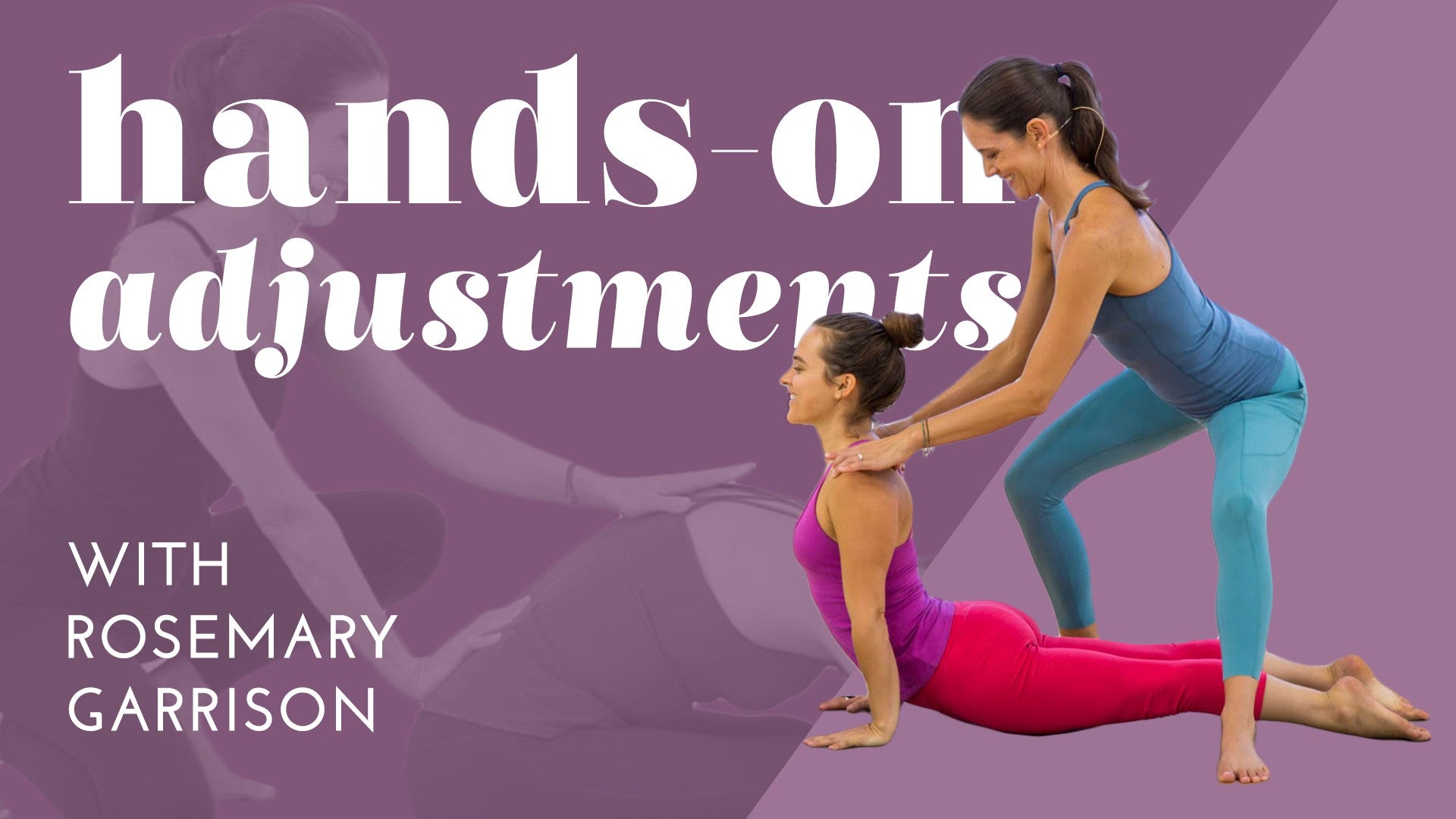Description
About This Video
Transcript
Read Full Transcript
Intro
I find it fascinating because there are so many specifics that will help a teacher adjust better and there are actual techniques that we can use, that we can learn. Ultimately, the big picture is about being with your student and seeing what's there. So rather than, oh, I learned this adjustment and my hand goes here and my other hand goes here and I'm just going to do that regardless of what this pose looks like in this body. It's like stepping back for a moment and seeing where that student is in that moment. What's the shape of his or her body and then what's useful?Maybe that adjustment doesn't even apply. Maybe there's another one. Maybe it's not time to touch. Maybe verbal cues would be better. Maybe they just need to kind of live and breathe in the pose for a little while first.
So I hope that all of these offerings are useful and applicable, but big picture, it's about seeing and being with your student and going from there.
Gain Consent
There are many ways to gain consent. It depends on your style and maybe even the studio where you're working. I've seen recently some studios have little, I don't know what to call them, buttons. And if a student doesn't want to be touched, they can just place it on their mat and that's a clear sign.I haven't personally worked with that, but I think it could be useful. What I like to do is address the class at the beginning. Say my style is to use hands-on adjustments. Is anyone uncomfortable with that? They might tell me then or to make it a little bit more private if they'd like to tell me more personally.
If I move towards you to adjust and you're not comfortable with that, just say no thank you, no offense. Often when I meet new students, I'll check in with them and make sure they're comfortable with that style. If I've taught a class for a really long time and I know everyone in the room, I don't mention it every single time I teach, but anytime there's a new student or if I'm uncertain if someone is clear, then I make sure they're given the space to say so. I think it's important to create, I don't know, and this is kind of intuitive, but to gauge the student's response or to gauge the student's need to tell me anything one-on-one. If it's a large class and I ask everyone at the beginning, maybe somebody doesn't necessarily want the whole class to know that she's not comfortable being adjusted.
If it's a new student and I sense that might be the case, I'll try to create an opportunity where I can address it one-on-one, or if that's not possible, when I'm actually approaching the body, the student, to say are you okay with a hands-on adjustment, and say it softly directly to them so it's not a real public event. I think it's also important to say that sometimes there's an intuitive sense with students, so maybe there hasn't been an opportunity for them to tell you that they're not comfortable with a hands-on adjustment, but over time you learn to kind of sense they're just not in the space to receive that for whatever reason. Sometimes it's body language, I can see a slight kind of moving away if I approach, or a very inner energy, like sometimes students literally have hair falling over their face or I don't know, maybe rounding of the shoulders, it's just, it's hard to explain, but I perceive that their energy is very internal and they're not receptive and they don't want their space invaded, and so I've just learned to trust that, and when in doubt don't adjust, unless they're doing something that's unsafe, in which case I can give a verbal cue, if I'm
Adjust with Intention
uncertain I give them their room. When I say adjust with intention, what I'm speaking to, well it has a few elements, but fundamentally it's about moving towards your students with awareness, with mindful energy, it's not a mechanical, I'm coming over here to move the shoulder blade there and the sacrum there and then I'm done and I walk away, it's like I'm present with them and I'm feeling into their bodies and their energy and what they may need. Very clearly, my intention always is to be respectful, always is to serve the practitioner, always to make sure that they are in safe alignment, and then it moves into a little bit more of an abstract territory, a deepening of the experience, a lengthening of the central channel, an expanse of the breath, whatever the specific adjustment is that's needed for that body and that pose, the metaphysical aim, if you will, is about yoga, it's about what's happening beyond the mechanics of the body and how can I facilitate that.
Make Your Presence Known
Yeah, this is so simple but so important, so I've had a number of experiences where I'm approaching a student and they don't necessarily know I'm there and I startle them and that's disruptive and not fabulous for the nervous system, like the whole essence of the practice is being in the pose and relaxing and engaging and energizing and if you jar someone while they're practicing, not so great. So I make my presence known so that they know I'm coming in to their space, to their physical body, to their energy body, I'm moving in. It's also for my own safety. If they can't see my body and I approach and they don't know I'm there, they could drop out of the pose, they could lift a leg and down dog, they could kick me in the face, any number of things. So respect for them, safety for my own body.The way that I do that, often I tend to breathe pretty loudly. I'm kind of constantly in a jive breath when I'm teaching. So often they can hear my breath and if not, I may just come near them and say, are you comfortable being adjusted or go ahead and exhale or I'm cueing the class verbally and so they hear my voice approaching them. So breath, gentle touch or I actually speak, let them know I'm there.
Ground Yourself First
Super essential to be aware of your own body and to stabilize yourself before you touch a student.Most obviously, if you're not firmly rooted, equal weight on your feet, you know that you have a firm foundation, you fall over and if you're bearing their weight, they could fall over. So you want to protect yourself, you want to be mindful of your student, it's a safety primarily issue and then if you're rooted, feet firmly planted or whatever your point of contact with the earth is, is firmly rooted, then they're going to feel that. That's transferred, I think, to their body. They feel like, ah, she's got me and I can really expand into this pose or drop into this pose, whatever it's called for. I feel like that's physically communicated and it's also energetically communicated.
Look for the Energy
So when I say look for where the energy is going, in some ways that is physical. For instance, in Down Dog, there's a hand on the sacrum grounding the body and then another hand lengthening the spine downward and I want the energy to be moving in both directions through the spine but there's more to it than that. There's the mechanics of the adjustment which create a safe, mindful, practical adjustment but then there's what's happening in the pose, what are we hoping for the practitioner and if we can facilitate that, the lengthening of the central channel, the opening of the heart, the expanse of the breath, that's what I'm most interested in. That's when the yoga comes alive. So once we feel comfortable with the fundamentals of the adjustment, the actual mechanics, we can look at the posture and kind of explore.For instance, maybe in a twisting side angle, we want the spine to be lengthening but we also want the chest, the heart to be opening. So how to facilitate that, how to make that happen and the actual, yes, I want one hand on the ribcage and one hand on the shoulder to help twist it open, yes, but also maybe we see the heart's going more kind of back and up than it is going forward and lengthening so maybe there's just a finger or two on the back of the heart to help create that. Use the fundamentals, like the major movements of the pose but then within that, where can it open a little bit more? And learning to see that in bodies, learning to see that in poses, what could open, what could expand, where could the energy move more freely? The other thing that I love about this is that I feel like we do downward dog day in and day out, day in and day out and it can become repetitive, it can become boring for a student, for a teacher, but if we're playing with the energy of it, for me, then it's never boring and it's like, ooh, it gets just more and more and more subtle and there's
Touch with Reverence
always more to explore.We explore this a little bit with touch, adjust, with intention, when I say touch with reverence I think it's moving into even a little deeper, ooh, makes me emotional. In my opinion, teaching is such a great honor and privilege and when we're actually touching another body, it's incredibly sacred space and it's, you know, we don't run around putting our hands on strangers' sacrums or hearts, we don't touch people in that way. And when we're adjusting students, we are and it's a privilege and it's an honor and I think it should be treated with an incredible amount of respect so that the fundamental energy behind the touch is reverent and respectful, even loving, and that that hopefully, I believe, is communicated to the student. So it's not, oh, I'm doing this wrong or I'm getting corrected or I could be better. It's like, oh, I'm receiving a kind, loving touch that's moving me deeper into my practice.
Be Clear and Decisive
This is where we can move into the realm of comedy a little bit. So we do not touch with, as we mentioned, with anything other than respect and reverence. We're not coming in for our own enjoyment, like, yes, there's a satisfaction of seeing someone's pose expand or open or deepen, of course, but it's for them. And so when I say clear and decisive touch, I mean, if your hand is on their sacrum, then your palm is on their sacrum and your fingertips are not sort of wisping around their butt, like, hands off of any intimate area. And then I think this is more subtle, but there's an energetic experience for the student.When you come in, I'm not talking about, like, slamming down, but come in and touch, like, I know I've got this. I'm touching you with confidence and conviction, and you can trust me. If it's like, ah, does my hand go here, or does it go here, or I put it there for a second and then I move it, I think that that's felt. And so the more we can practice this so that we can adjust in that way, the better. So part of it is just, like, clean, respectful boundaries of the physical body, and part of it is an energetic communication of, like, you're safe.
Center of the Body
I've got you. Your body is okay, and I'm going to hold you in this. It's important to work as close to the center of the body as possible for a couple reasons. And I think the best example is maybe the hands interlaced behind the back in Prasarita Padottanasana or just in a standing forward fold. So for instance, if I have one hand on their sacrum, I want the other hand on their upper arms or maybe forearms, but not all the way down to the wrists.And the reason for that is pressing on the wrists create more strain in the joints, the wrists, the elbows, all the way up into the shoulders. Whereas if I'm here on the upper arms, it's really emphasizing the opening of the shoulders, the upper back, the chest, rather than kind of locking out into or straining the joints. The other is really straightforward. The farther away from their center of gravity you are, the easier it is to throw them off
Release the Adjustment Mindfully
balance and just knock them out of the pose, so not a good idea. Release the adjustment mindfully, kind of similar to what we were just exploring around working close to the center of the body.If you're holding their balance in any way and you just step off, they could very easily fall. So on a practical level, you want them to have their balance before you step away. And then on that unseen energetic level, if you're making contact with them and you're in relationship with their body, deepening them into the pose, and then you just bail, it's a little abrupt as the practitioner. If you can ease off, it's like, okay, now you've got yourself and I'm going to slowly step away. So for their safety, for their balance, and also for the overall experience, moving in
Release the Energy
and out of their field slowly and intentionally.So release the energy developed for me after years and years of teaching. I honestly don't know what's happening scientifically, maybe nothing at all, but it feels good for me and I've had students give me feedback that they really enjoy it as well. It depends. It's not every adjustment by any means. Often when I'm working with the spine, for instance, if I'm adjusting child's pose, I have a hand on the sacrum and a hand on the upper back heart area.
When I'm done, I might release this hand and then this, and then kind of swipe their back a little. I don't know. It's like, huh, whatever's getting stirred up from the yoga, whatever obstacles are getting
Watch Your Own Stuff
cleared. It's like we help to just send them on their way. Yeah, okay.So we're human. Like, yeah, we're yoga teachers and hopefully we're pretty well practiced and when we're teaching especially, we're in a pretty clean space and we're human. And who knows? Maybe a new student comes in who looks like an ex or reminds you of someone you had a big issue with in high school or any number of individual personal triggers or is mastering a pose that you've struggled with your whole life and you just can't do it. I don't know.
Those are just a few thoughts. If something is agitating you and you can't adjust them cleanly with your own stuff checked, just don't adjust them and step back from the students, step back from the class, take your own time to do your own self-examination and clear that out, especially if you're going to be working with them over time. It speaks to intention and it speaks to reverence. If you can't adjust from that space because of whatever's going on in your own field, then just don't offer the adjustment.
Hands On Adjustments: The Postures of Sun Salutations
Comments
You need to be a subscriber to post a comment.
Please Log In or Create an Account to start your free trial.














